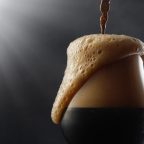 Festival goers can expect to find 120 festival-exclusive beers and cocktails at GABS, which is now in its 14th year.
Festival goers can expect to find 120 festival-exclusive beers and cocktails at GABS, which is now in its 14th year.  Festival goers can expect to find 120 festival-exclusive beers and cocktails at GABS, which is now in its 14th year.
Festival goers can expect to find 120 festival-exclusive beers and cocktails at GABS, which is now in its 14th year.  Festival goers can expect to find 120 festival-exclusive beers and cocktails at GABS, which is now in its 14th year.
Festival goers can expect to find 120 festival-exclusive beers and cocktails at GABS, which is now in its 14th year. The main harvest window for citrus fruits runs from November to March, so why isn’t that period citrus beer season?
The post Citrus Sunshine in the Cold Winter appeared first on CraftBeer.com.
LONG BEACH, CA – Whether you’re celebrating with a soulmate, raising a glass with your best friend, or indulging in a little well-deserved self-love, Beachwood Brewing & Distilling has crafted a specialty lineup of Valentine’s Day cocktails to set the mood. From Wednesday, February 5, through Sunday, February 23, sip on a selection of specialty […]
The post Beachwood Brewing & Distilling Unveils Valentine’s Day Cocktail Lineup & Events appeared first on The Full Pint - Craft Beer News.
 One of the classic styles, and one of the most fabulous beers steeped in history, Kölsch is often underrated and overlooked.
One of the classic styles, and one of the most fabulous beers steeped in history, Kölsch is often underrated and overlooked. There’s an old saying in winemaking that it takes a lot of great beer to make great wine. But in the brewing industry, it takes plenty of great tacos to make great beer.
The post Tacos & Beer: Fueling the Yakima Valley’s Hop Harvest appeared first on CraftBeer.com.
 The Byron Bay brewery is gifting $10,000 grants to five beer fans to pursue their wildest travel dreams.
The Byron Bay brewery is gifting $10,000 grants to five beer fans to pursue their wildest travel dreams.  Slated to open in November, the new venue will be Mountain Culture's first inner-city joint, housing the brewery's new barrel program.
Slated to open in November, the new venue will be Mountain Culture's first inner-city joint, housing the brewery's new barrel program. In an industry historically dominated by males, women in the Vermont beer industry are woven into the fabric of the breweries.
The post The Women of Beer in Vermont appeared first on CraftBeer.com.
The market is responding to the growing demand for flavorful, well crafted non-alcohol beer.
The post The NA Way: The Rise of Non-Alcohol Beer appeared first on CraftBeer.com.
 This week I take a look at fermentation considerations when brewing a very high gravity beer such as an Imperial Stout or Barley Wine. Last week in Part 1, I covered several methods for achieving a very high starting gravity. Selecting Your Yeast Now that you have a high gravity wort, you need to consider […]
This week I take a look at fermentation considerations when brewing a very high gravity beer such as an Imperial Stout or Barley Wine. Last week in Part 1, I covered several methods for achieving a very high starting gravity. Selecting Your Yeast Now that you have a high gravity wort, you need to consider […]  Weather conditions led to reduced hop yields across the board, but high alpha and oil levels indicate a promising crop.
Weather conditions led to reduced hop yields across the board, but high alpha and oil levels indicate a promising crop. My book, American Sour Beers, is turning ten next month! I wrote it from the perspective (and experience) of a homebrewer. I wanted to experiment and learn. I really didn't know much about brewing commercially, creating consistent blends, adapting recipes as a barrel program matured, developing flavors that would sell etc. Looking back I have to ask, did my book help launch 1,000 barrel programs, without providing the knowledge brewers actually needed to succeed?
Over the last decade American craft brewing had an explosion of breweries ramping up barrel-aged sour production, followed by a pretty rapid decline (including multiple mid-sized breweries closing their programs and sour-focused breweries closing). Part of that is the inherently less-predictable nature of mixed-fermentation (when you order a cherry sour beer, what are you expecting? Kriek, cherry juice, cherry vinegar etc.). Compare that to a bourbon-barrel vanilla-bean stout where you have a pretty good idea of what the intent was. I suspect at least part of it was the oversaturation of the market combined with the high prices.
Despite brewing my first sour beer in 2006, becoming a brewery consultant in 2011, writing a book in 2014, and opening a brewery in 2018... I haven't been consistently happy with the barrel-aged mixed-fermentations I made until the last couple years. I certainly never released a beer that I thought was bad, but there were certainly had batches that were too sour, muddled, under/over carbonated, or just didn't "pop." During that time we've also released some amazing beers that I still love!
At Sapwood Cellars we've relied on our local club members, and the people who walk in the door to buy ~10,000 bottles of barrel-aged sour beer a year. That may sound like a lot, but it's less than 5% of our production (and we're a pretty small brewery). There really hasn't been much interest in barrel-aged sour bottles in our limited distribution range. They tend to be beers that sell best when you can explain them directly to the drinker, rather than just have them sitting on a shelf! If only there was a way I could talk directly to beer drinkers interested in sour beer...
The first installment of the club is $146 (including shipping) for one 500 mL bottle each of six beers:
Growth Rings 2023: Three-year-blend of barrel-aged Sours, essentially our cuvee of bases, barrels, and microbes showing off our house character. This one isn't refermented with wine yeast, so the dregs would be a good option if you are looking for microbes! It was the second highest-rated "Gueuze" on Untappd in 2023!
Barrels of Rings: Our pale ale base, mixed-fermented in wine barrels and then dry hopped right before bottling. Citrusy-funky with restrained acidity.
Jammiest Bit: Our homage to Hommage, a barrel-aged sour on loads of sour pie cherries and red raspberries. Fruity, funky, tart etc.
Botanicia: A blend of pale sours aged in gin barrels that we then infused with dried limes and quinine. A weird play on a gin-and-tonic... but with a lot more acidity and funk!
Elliptical Orbit 2023: A continuation of the "Dark Funky Saison" series still with my original collaborator and homebrew buddy Alex. For this one he roasted Geisha coffee beans and we infused the barrel-aged dark sour with Geisha cascara (dried coffee cherries).
Fruit of Many Uses: We sequentially racked the same barrel-aged tart/funky base onto second-use Chardonnay wine grapes, cherries, raspberries, and white nectarines. All of the fruit was whole/local.
Over the next couple weeks I'll be posting my detailed tasting notes on each of the beers, along with recipes, lessons learned, and suggestions for brewing something similar at home! I'll repeat for each club release, assuming enough people sign-up for the club to make it viable.
Over the last five years it isn't "one simple trick" we learned that improved our beer. It's the accumulation of 100 little things from ingredient selection, to blending, to process refinement, to equipment that we've figured out. It's sitting down with each beer, drinking, thinking, taking detailed notes, and iterating. So much of it is not doing it by myself, having Scott, Ken, and Spencer to push to do things I wouldn't have (Botanica was Ken's baby, and Barrels of Rings was Scott's). Both are delicious, and they are certainly beers I would not have brewed if it was all up to me!
 Pirate Life South Melbourne brings high energy food and beverage experiences to a former mechanics garage.
Pirate Life South Melbourne brings high energy food and beverage experiences to a former mechanics garage. In addition to music venues, bodacious barbecue, and epic tacos, this booming metropolis is The Lone Star State’s leading locale for incredible craft beer.
The post Three Beer-Filled Days in Austin, Texas appeared first on CraftBeer.com.
 Dr Charlie Bamforth joins me this week to discuss Dimethyl Sulfide (DMS) in beer and how to manage it. Subscribe on iTunes to Audio version or Video version or Spotify or Google Play Download the MP3 File– Right Click and Save As to download this mp3 file. Your browser does not support the audio element. […]
Dr Charlie Bamforth joins me this week to discuss Dimethyl Sulfide (DMS) in beer and how to manage it. Subscribe on iTunes to Audio version or Video version or Spotify or Google Play Download the MP3 File– Right Click and Save As to download this mp3 file. Your browser does not support the audio element. […]  Adam Mills joins me this week to discuss the use of Thiol boosting yeast, mash hopping and other techniques to enhance the tropical/fruity flavors in IPAs and New England IPAs. Subscribe on iTunes to Audio version or Video version or Spotify or Google Play Download the MP3 File– Right Click and Save As to download […]
Adam Mills joins me this week to discuss the use of Thiol boosting yeast, mash hopping and other techniques to enhance the tropical/fruity flavors in IPAs and New England IPAs. Subscribe on iTunes to Audio version or Video version or Spotify or Google Play Download the MP3 File– Right Click and Save As to download […] (HERSHEY, PA) – Tröegs Independent Brewing announces the release of Field Study, an IPA inspired by the brewery’s annual trip to the Pacific Northwest’s Yakima Valley for hop selection. Like many of its […]
The post Tröegs Independent Brewing Announces Field Study IPA appeared first on The Full Pint - Craft Beer News.
 This week Chris Graham and Vito Delucchi from MoreBeer join me to discuss how to free the thiols in your hops to create fruity IPAs and New England IPAs. Subscribe on iTunes to Audio version or Video version or Spotify or Google Play Download the MP3 File– Right Click and Save As to download this […]
This week Chris Graham and Vito Delucchi from MoreBeer join me to discuss how to free the thiols in your hops to create fruity IPAs and New England IPAs. Subscribe on iTunes to Audio version or Video version or Spotify or Google Play Download the MP3 File– Right Click and Save As to download this […] From brewery hotels to campgrounds, quirky Airbnbs to luxurious resorts, this is your guide to planning a craft beer weekend getaway.
The post AirbnBeers: Breweries with Hotels, Inns, Camping and More appeared first on CraftBeer.com.
 This week I cover some of the changes you need to make to brew a high gravity beer using BeerSmith software. High gravity beers (generally over 1.060 or so) do require some minor changes to your recipe and equipment profile as well as some process changes for brewing. High Gravity Brewing Considerations I’ve written a […]
This week I cover some of the changes you need to make to brew a high gravity beer using BeerSmith software. High gravity beers (generally over 1.060 or so) do require some minor changes to your recipe and equipment profile as well as some process changes for brewing. High Gravity Brewing Considerations I’ve written a […] Dozens of U.S. growers supply breweries with high-quality hops. These hop farms are often family-run, and count their acreage in double-digits vs. thousands.
The post Craft Hop Growing in the U.S. appeared first on CraftBeer.com.
Summer is here! Melissa Corbin serves up 11 craft-beer destinations and happenings, from the Pacific Northwest to the Deep South.
The post A Toast to Summer: Festivals, Patios, and Benefits appeared first on CraftBeer.com.
 This week I’m going to cover how you can run BeerSmith desktop in a variety of languages using the language files available online. With the worldwide popularity of our BeerSmith software, I often get users asking if it is available in non-English versions. Fortunately the software was designed with this in mind, so there are […]
This week I’m going to cover how you can run BeerSmith desktop in a variety of languages using the language files available online. With the worldwide popularity of our BeerSmith software, I often get users asking if it is available in non-English versions. Fortunately the software was designed with this in mind, so there are […]  This week I take a look at how to incorporate separately steeped dark grains with BeerSmith, a technique often used to minimize burnt, harsh roast grain flavors in the finished beer. Steeping/Sparging vs Mashing Dark Grains As I covered in this original article on the topic, all grain brewers can be well served by separately […]
This week I take a look at how to incorporate separately steeped dark grains with BeerSmith, a technique often used to minimize burnt, harsh roast grain flavors in the finished beer. Steeping/Sparging vs Mashing Dark Grains As I covered in this original article on the topic, all grain brewers can be well served by separately […]  This week I’m going to cover the two major methods (in two parts) used to create sour beers at a home brew level. While sour beer brewing is considered a more advanced brewing technique, it is possible for even a beginning homebrewer to create great sour beers using these methods. Sour Beer Basics Sour beers […]
This week I’m going to cover the two major methods (in two parts) used to create sour beers at a home brew level. While sour beer brewing is considered a more advanced brewing technique, it is possible for even a beginning homebrewer to create great sour beers using these methods. Sour Beer Basics Sour beers […]  This week I take a look at the shopping list and inventory features available on BeerSmith Web. These features were added in March of 2022 to the web based version which you can try for free on BeerSmithRecipes.com from any computer, tablet or phone. The web based version provides a common view of inventory and […]
This week I take a look at the shopping list and inventory features available on BeerSmith Web. These features were added in March of 2022 to the web based version which you can try for free on BeerSmithRecipes.com from any computer, tablet or phone. The web based version provides a common view of inventory and […]